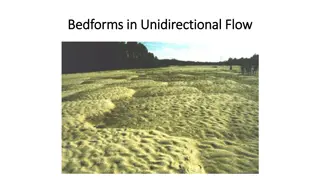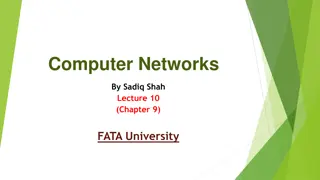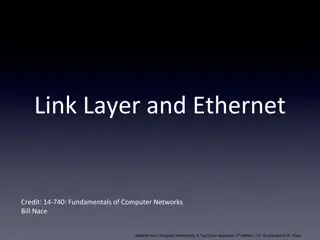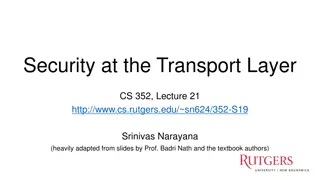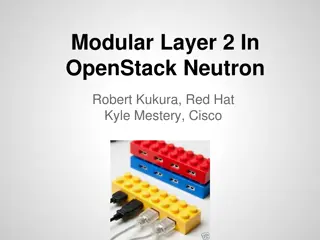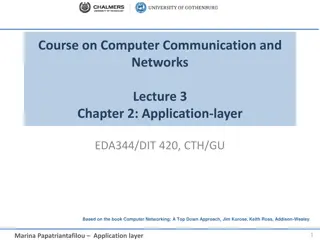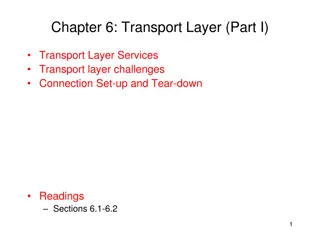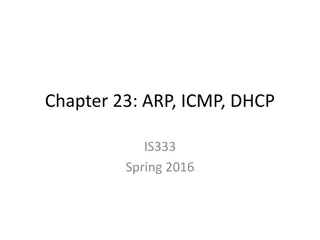Understanding RARP and Transport Layer in Computer Networking
Exploring Reverse Address Resolution Protocol (RARP) for mapping physical addresses to logical addresses in networking, along with insights on the Transport Layer's role in providing communication services to application processes. Learn about RARP packet formats, encapsulation, and the significance of the Transport Layer in managing data segments for efficient communication between hosts.
Download Presentation

Please find below an Image/Link to download the presentation.
The content on the website is provided AS IS for your information and personal use only. It may not be sold, licensed, or shared on other websites without obtaining consent from the author. Download presentation by click this link. If you encounter any issues during the download, it is possible that the publisher has removed the file from their server.
E N D
Presentation Transcript
Dr. Naveed Ahmad Assistant Professor Department of Computer Science University of Peshawar
RARP finds the logical address for a machine that only knows its physical address.
Note: The RARP request packets are broadcast; the RARP reply packets are unicast.
Transport Layer Transport layer is located between the network layer and the application layer. The transport layer is responsible for providing services to the application layer; it receives services from the network layer. TCP/IP Protocol Suite 7
Provide logical communication between application processes running on different hosts Run on end hosts Sender: breaks application messages into segments, and passes to network layer Receiver: reassembles segments into messages, passes to application layer Multiple transport protocol available to applications Internet: TCP and UDP application transport network data link physical network data link physical network data link physical network data link physical network data link physical network data link physical application transport network data link physical
Purpose: Track individual communication between applications on source/destination hosts Segment data and manage each piece of data prepares it to be sent across the network (network layer). Re-assemble segments back into streams of application data at the receiving host. Identify the different applications using port numbers. Each software process that needs to access the network is assigned a port # that is unique in that host. Indicates which application that piece of data is associated with.
Network layer versus transport layer TCP/IP Protocol Suite 11
Web browsers E-mail File transfers DNS VoIP Video streaming
UDP Connectionless Advantage low overhead data delivery pieces datagrams Best Effort delivery Used by application that don t require reliable delivery Minimal delays TCP connection-oriented More overhead Same order delivery Reliability flow-control
Source ports Dynamically and randomly assigned by the originating device from port # s > 1023 Must not conflict with other ports in use at the time Acts as a return address of sorts for the requesting application Destination port Port # assigned to the service daemon running on the remote host Must know which layer 4 protocol (TCP/UDP) and which application (port #) Many common applications have default port # assignments Socket - combination of IP address and port # 192.168.100.48:80 would be HTTP on that IP address
Port Application Description 9 7 19 20 21 23 25 53 79 80 88 110 119 161 179 513 Discard Echo Chargen FTP-Data FTP-CMD Telnet SMTP DOMAIN Finger HTTP Kerberos POP3 NNTP SMTP BGP Rlogin Discard all incoming data port Echo Exchange streams of data port File transfer data port File transfer command port Telnet remote login port Simple Mail Transfer Protocol port Domain Name Service Obtains information about active users Hypertext Transfer Protocol port Authentication Protocol PC Mail retrieval service port Network news access port Network Management Border Gateway Protocol Remote Login In
IANA Internet Assigned Numbers Authority assign port # s Port # s 0-1023 Well know ports reserved for services & applications 1024-49151 registered ports assigned to user processes or applications. May be used as a dynamically selected source port 49152-65535 Dynamic or private ports (Ephemeral ports).
TCP/UDP TCP 20&21 FTP 23 Telnet 25 SMTP 80 HTTP 110 POP3 443 - HTTPS UDP 69 TFTP 520 RIP 53 DNS 161 SNMP
Utility that can be used to verify connections. Lists the protocol, the local address and port #, foreign address & port #, and the state of the connection Drop out to command line and try it >netstat >netstat n (notice the port # after the : in the foreign ip address) (you will have to identify port # here on your test!)
Dividing data into manageable pieces ensures data is transmitted within the limits of the media and can be multiplexed onto the media.
TCP & UDP do this differently TCP sequence # s are used for reassembly at the destination in the correct order. Data is ensured to be in the exact form the sender intended. UDP not concerned with order or maintaining a connection. Generates less overhead which means faster data transfer. Applications that use UDP must tolerate the fact that data may not arrive in the order that it was sent. Does NOT require reliable delivery of packets.
The key distinction between UDP and TCP is the reliability you get with TCP discuss the fields. Source/destination port # s are on TCP and UDP Headers
An individual server cant have 2 services assigned to the same port # within the same transport layer services.
Steps to establish a connection 1) The sender sends an initial SEQ value (set by TCP) to begin communication! 2) The receiver responds with an ACK value = to the SEQ value + 1. The ACK should always be the NEXT expected Byte. 3) Sender responds with an ACK value = to SEQ value it received + 1.
B A Each host tells its ISN to the other host. Three-way handshake to establish connection Host A sends a SYN (open) to the host B Host B returns a SYN acknowledgment (SYN ACK) Host A sends an ACK to acknowledge the SYN ACK
As port B s port A s Initial Sequence Number Flags: SYN FIN RST PSH URG ACK Acknowledgment Advertised window 20 Flags 0 Checksum Urgent pointer Options (variable) A tells B it wants to open a connection
Bs port A s port B s Initial Sequence Number Flags: SYN FIN RST PSH URG ACK A s ISN plus 1 Advertised window 20 Flags 0 Checksum Urgent pointer Options (variable) B tells A it accepts, and is ready to hear the next byte upon receiving this packet, A can start sending data
As port B s port Sequence number Flags: SYN FIN RST PSH URG ACK B s ISN plus 1 Advertised window 20 Flags 0 Checksum Urgent pointer Options (variable) A tells B it wants is okay to start sending upon receiving this packet, B can start sending data
Suppose the SYN packet gets lost Packet is lost inside the network, or Server rejects the packet (e.g., listen queue is full) Eventually, no SYN-ACK arrives Sender sets a timer and wait for the SYN-ACK and retransmits the SYN-ACK if needed How should the TCP sender set the timer? Sender has no idea how far away the receiver is Hard to guess a reasonable length of time to wait Some TCPs use a default of 3 or 6 seconds
User clicks on a hypertext link Browser creates a socket and does a connect The connect triggers the OS to transmit a SYN If the SYN is lost The 3-6 seconds of delay may be very long The user may get impatient and click the hyperlink again, or click reload User triggers an abort of the connect Browser creates a new socket and does a connect Essentially, forces a faster send of a new SYN packet! Sometimes very effective, and the page comes fast
Timeout Timeout Timeout Timeout Timeout Timeout ACK lost DUPLICATE PACKET Early timeout DUPLICATE PACKETS Packet lost
Sender sets a timeout to wait for an ACK Too short: wasted retransmissions Too long: excessive delays when packet lost TCP sets timeout as a function of the RTT Expect ACK to arrive after an RTT plus a fudge factor to account for queuing
If an acknowledgement isnt sent that data was received, the host will RESEND the data because it has reached a timeout.
Window size the amount of data a source can transmit before an ACK must be received. It enables the management of lost data and flow control.
Go over characteristics of UDP used by DNS, SNMP, DHCP, RIP, TFTP, Online games, streaming video, etc.
Describe how servers use port numbers to identify a specified application layer process and direct segments to the proper service or application









